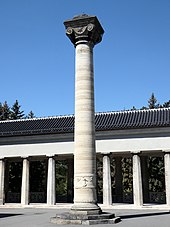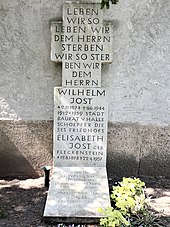Gertraudenfriedhof (Halle)
The Gertraudenfriedhof in Halle (Saale) is a listed cemetery that was built between 1912 and 1914 in the north of the city. The cemetery is listed in the register of monuments of the city of Halle under registration number 094 04815. City planning officer Wilhelm Jost created the design .
history
The cemetery was built to relieve the southern cemetery . It got its name in reference to the former inner-city cemetery of the parish church of St. Gertruden, which was removed in the course of the construction of the ship of the market church and the construction of the market square.
Buildings
The Gertraudenfriedhof is the largest cemetery in Halle (Saale) with a total area of about 37 hectares. The central component of the architecture is the tower-like, almost cube-shaped, monumental temple-like funeral hall with crematorium . The hall, which can be reached from the forecourt by a wide flight of stairs or by ramps running at right angles from a terrace, was covered with a flat hipped roof. The central building is flanked by colonnades of columns in Doric style with lounges that end in columned galleries.
Two 10 meter high painting columns on the terrace, referring to antiquity and on which a dance of death relief is depicted, are remarkable . They originally carried larger-than-life figures that have been missing since December 1988. The columns were created by Paul Horn . The death dance relief was created by his son Richard Horn .
The functional buildings of the cremation association follow to the west. The problematic design of the two chimneys at every crematorium was solved by placing them behind the chapel and creating a connecting candle arch . Since 1993 there has been a new cremation facility on the site of the cremation association behind the small celebration hall.
The inside of the funeral hall consists of a high rotunda with a dome supported by simple Doric columns. The inside of the dome is decorated with frescoes by Karl Völker ; underneath a picture motif "angel cycle".
In front of the hall there is a large, rectangular water basin lined with tall poplars , in which the celebration hall is reflected.
The columbarium located north of the main axis at the level of the water basin is an open system on a rectangular floor plan, which was only completed in 1936. The limestone walling is structured by large round arches in which the urn niches are located.
There are also 58 different wells and water intake points in the cemetery, most of which were created by Richard Horn.
Monuments and burial grounds

In the cemetery there are or were several significant monuments, works of art and facilities; they include:
- The 25-figure sculptural group The Endless Road within the Columbarium, led by Death, created 1972–1976 by Richard Horn
- Memorial for the bomb victims of 1944/45 : Exactly in the middle of the cemetery complex a large base (from a previous memorial ) bears a peace dove and the inscription: The 689 bomb victims in this cemetery urge peace . The grave fields with the victims of the air raids on Halle (Saale) are not far from the memorial on "Department 25". Each dead person received a lying tombstone with name, year of birth and death. The decayed limestones from the post-war period were replaced by weather-resistant natural stones in 1995.
- Memorial field for 679 "murdered by the National Socialist state": Obelisk and individual stones by the sculptor Richard Horn from 1948/1949
- Memorial field of the Anatomical Institute with steles for anonymously buried people who made their bodies available for anatomical research
- Memorial complex for the fallen of both world wars
- Urn cemetery for Torgau prisoners from 1950–1953
- Memorial for the dead of the Soviet garrison in Halle: artificial stone pyramid and artificial stone wall with the names of the dead by Henry Cyrenius from 1948/1949
- Memorial to the dead of the socialist labor movement: Obelisk by Edi Reissner and Heinz Stiller from 1965
- Lime sandstone relief Passion : erected in 1948 in memory of the victims of fascism by the sculptor Herbert Volwahsen
- Monument to the March fighting in central Germany fallen time volunteer : It was built from donations of citizenship and on Ascension Day 1921 (5 May) unveiled. It was destroyed after the Second World War . The cross inscription was from the Gospel of John (15:13):
Graves of famous people
Walther Siegmund-Schultze.jpg
One of the graves of well-known personalities in the Gertraudenfriedhof is the grave of Wilhelm Jost , who also designed large parts of the complex in his role as town planning officer.
- Hans Vaihinger (born September 25, 1852 in Nehren near Tübingen, † December 18, 1933 in Halle (Saale)), philosopher and Kant researcher; (former) burial place between compartments I and II (abandoned)
- Wilhelm Jost (born November 2, 1874 in Darmstadt; † June 6, 1944 in Lohdorf bei Hohensalza), architect and city councilor in Halle, burial place in direct line of sight to the large celebration hall on the western boundary wall on Bergschenkenweg
- Reinhold Lohse (born October 12, 1878 in Glaucha; † November 16, 1964 in Halle (Saale)), street musician; Department IX voting point 141 (honor grave of the city of Halle)
- Richard Horn (born January 21, 1898 in Berlin; † October 6, 1989 in Halle (Saale)), sculptor and co-designer of the Gertraudenfriedhof, columbarium
- Walther Siegmund-Schultze (born July 6, 1916 in Schweinitz, Province of Saxony, † March 6, 1993 in Halle (Saale)), musicologist, co-founder of the Halle Handel Festival; Grave place Department XIII Special grave 31
- Krystyna Wituska (born May 12, 1920 in Jerzew / Poland, † June 26, 1944 in Halle (Saale)), Polish resistance fighter, murdered by the National Socialists; Grave place Department V. Honor stele
- Willi Sitte (born February 28, 1921 in Kratzau, Czechoslovakia, now the Czech Republic; † June 8, 2013 in Halle (Saale)), German painter and graphic artist, President of the Association of Visual Artists (VBK) of the GDR; Burial place Department XI Special burial site 126–127
- Christa Susanne Dorothea Kleinert (born September 21, 1925 in Neurode / Silesia; † February 14, 2004 in Halle (Saale)), German economist; Burial place department Vc119
New Jewish cemetery
Part of the total area is the New Jewish Cemetery, which was built as a separate facility. In 1929 the cemetery with the entrance at Dessauer Strasse 24 was inaugurated as the fourth Jewish cemetery. The Leipzig architect Wilhelm Haller built the funeral hall, the most important expressionist architectural creation in Halle at the time .
The renovation in February 1941 and an extension in May 1942 changed the exterior completely. The cemetery hall was now used as a Jewish retirement home and assembly camp for Jews from Halle, the Saar region, the Palatinate and Baden. From here they were deported to Theresienstadt and from there to Auschwitz .
The cemetery also includes a Jewish memorial field with a total of 180 tombs , some of which are from the Middle Ages . It was created when the burial ground at Töpferplan, the second old Jewish cemetery, was forcibly closed in 1937 and the best-preserved tombs were integrated into the new Jewish cemetery.
The Jewish Community of Halle is responsible for the cemetery.
literature
- Association for cemetery culture in Halle and the surrounding area eV / Kathleen Hirschnitz (Hrsg.): Nature and art - architecture and landscape. 100 years of Gertraudenfriedhof in Halle (Saale). Hasenverlag, Halle 2014, ISBN 978-3-945377-07-9 .
- Holger Brülls, Thomas Dietzsch: Architectural Guide Halle on the Saale. Dietrich Reimer, Berlin 2000, ISBN 3-496-01202-1 .
- Michael Pantenius: City Guide Halle. Gondrom, Bindlach 1995, ISBN 3-8112-0816-0 .
- Rose-Marie Frenzel, Reiner Frenzel: Art and culture guide Leipzig-Halle. Edition Leipzig, Leipzig 1993, ISBN 3-361-00351-2 .
- Jewish community in Halle (ed.): 300 years of Jews in Halle. Life, achievement, suffering, wages. Mitteldeutscher Verlag, Halle 1992, ISBN 3-354-00786-9
Web links
- Cemetery culture in Halle: Gertraudenfriedhof
- Hall in the picture: Gertraudenfriedhof
- The Gertraudenfriedhof on the official website of Halle (Saale)
- On the history of the Jewish community in Halle (Saale)
- The Jewish cemeteries in Halle
Individual evidence
- ↑ State Office for the Preservation of Monuments in Saxony-Anhalt (ed.): List of monuments in Saxony-Anhalt / City of Halle. Fly Head Publishing, Halle 1996, ISBN 3-910147-62-3 . P. 266.
- ↑ Aribert Schwenke: Temporary Volunteer Associations and Hallenser SC during the unrest in 1919–21. In: then and now . Volume 31, 1986, pp. 47-72.
Coordinates: 51 ° 30 '17.3 " N , 11 ° 59' 4.5" E







